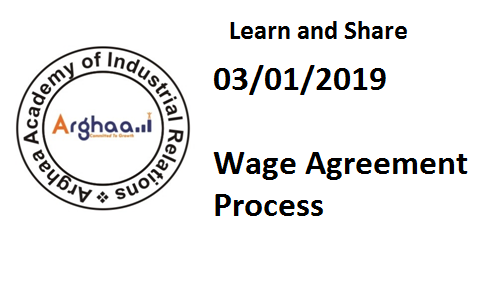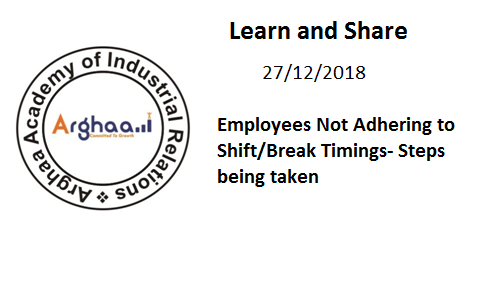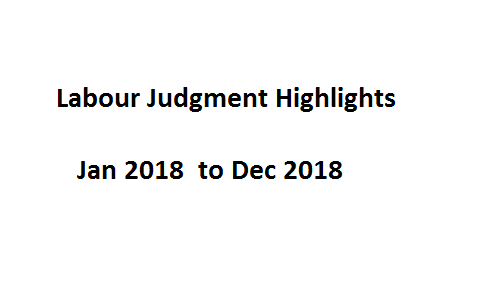[5:55 PM, 1/3/2019] HR. Rajan Babu: Lets discuss and share the process of wage agreement either with Union or Committee
[7:06 PM, 1/3/2019] HR Ganesan Ex Hwashin:
· 1.Submission of charter of demands by the union or workers' committee.
· 2 Serving of counter demands by the Management based on our existing business and trend in the next years. Whatever the issues and differences faced in the past years could be listening in the counter demand. The counter demand can also include expectations by the plant and management from the workers and the union in running the business viable in the years to come. Multi skill or multi machine concept, productivity increase, increase in UPH, cost control measures , Settlement tenure , change management requirements etc could be main demands by the Management generally.Ofcourse requirements by the companies may varey from one to another plant.I know VRS is one of the demands by the Management in their counter.
· 3 Preparation of report and data collection on the other units in that area.
· 4 .Converting the workers demand into CTC in details namely monthly and annually.
· 5.Form the Management negotiation team : involve sales/ finance / production head / OR head
· 6.See that team talks confidentially and one language with company goal. No ego in the meeting while talk to union..We should understand that union is committed and United and controlled among themselves.
· 7.Decide whether go through Labour dept or mutual discussions or both as strategy.
· 8.In the beginning 3or 4 meetings only business talks and thereafter talks on counter demands or talks on union demands or both as the case may be. In negotiation it all depends on the unit relationship or culture. Attend meeting in time and schedule next meeting with consulting the party. Finish the meeting almost in time. When you go for meeting go with data and all particulars. You allow the party to talk and give reply to them with facts and figures. When union is on the higher hand you just trap them by giving quality defects, delivery failures ,worker indiscipline etc.
· 9 Also look for feed back after the meeting from the plant within 1 or 2 days or within 1or 2 shifts.
· 10 Some meeting you have in the plant and few outside the plant at closing of the settlement. Arrive at mutual agreed points. Draft a settlement and check with other management committee members for clarity and perfection.
· 10Reaching the settlement. Explaining the settlement to workers or management staff
· 11. Implementing the settlement in letter and spirit
[9:38 PM, 1/3/2019] HR. Rajan Babu:
Any negotiation with a trade union should aim to achieve a mutually acceptable outcome. But when making changes to employees' terms and conditions, there can be a lot at stake for those affected.
Here are few ground rules/steps that we can take to ensure that the bargaining process runs as smoothly as possible.
1. Ensure you have to negotiate
· We subject to compulsory trade union recognition will have to negotiate with their recognized trade union or committee if they are planning to make changes to pay hours or holidays.
2. Prepare the business case
· The better prepared we are the more likely it is going to be able to marshal the arguments and back them up with evidence.
· Points to consider include: how their objectives might be met; the consequences of not making the changes; and how to manage the changes from an employee point of view.
· We should keep an open mind during negotiations, and be realistic about what can be achieved.
3. Remember legal entitlements of union representatives
· Employee trade union representatives are entitled to paid time off to carry out their union duties - this includes preparing for meetings, attending negotiations and meeting members afterwards. They also have a right to receive "relevant information" from us/ employer, without which they would be impeded in carrying out collective bargaining.
4. Understand the unions' decision-making structure
· The representatives of the union are likely to be members who are acting on behalf of union members, but more complex negotiations may require a full-time official from the union to be involved. Any offer made to the union representatives will have to be taken back to union members for ratification before it can be implemented.
5. Try to secure an agreement
· By maintaining a spirit of cooperation and working with the trade union/ committee are more likely to secure agreement with them. Simple things like explaining why the unions' demands cannot be met will also help, while listening to the trade unions'/ committee arguments may help us/ employer see an alternative way of meeting its objectives.
6. Do not forget non-union employees
· When negotiations cover a particular bargaining unit at an organization, the outcome will affect all employees within the unit, not just those that are members of the trade union, so be sure to communicate with them as well.
[7:44 AM, 1/4/2019] HR Murugavel Hyundai Steel:
· Receive COD from the Union/ Worker Representation Committee(WC)
· Invite for a meeting to discuss COD and management expectation/requirements
· 3 Prepare a non- committal minutes of meeting and keep a record.
· 4 . Keep the disagreement clauses separately.
· 5 . Explain with justified reasons of management stand on disagreement clauses.
· 6. Filter/ minimize the clauses of disagreement on COD.
· 7 . Review the filtered disagreement clauses shall be taken for consideration during the period of settlement and specify.
· 8. Any demands not permits for consideration drop it and record the reasons.
· 9. Prepare a wage settlement as package deal.
· 10. Mention the unsettled demands are dropped and no additional / fresh demands shall be considered during settlement.
· 11. Mention the short recital of discussion in wage agreement.
· 12. Clearly mention the list of beneficiaries of settlement and effective date.
· 12-A) Explain clearly the terms of settlement before sign off.
· 13. Prepare the agreement in specified format Form B
· 14. Incase of 12(3) sign of in the presence of ACL/JCL
· 15. Incase of 18(1) signed by the parties to settlement.
· 16. Copy of wage settlement should be sent to office of ACL,JCL, Commissioner of labour, Secretary of Labour Dept and to the party of settlement.
· 17, Ensure the wage agreement covers productivity/quality/safety/introduction of new technology and modernization as per business requirement.
· 17-A) Explain the effective clauses on each terms with prospective/retrospective/ from the specified date.
· 18. Have a safety clause in settlement in case of any breach on the terms settled through legal means not by a strike or lock-out.
[11:46 AM, 1/4/2019] HR. Rajan Babu:
Before you receive the Charter of Demands
· Collect all information for the past years ( At least Previous two settlements)
· Prepare as a table- This would help to understand what is being demanded and also the trend of settlements being arrived.
· Collect all information regarding Production, Productivity , Absenteeism , Safety data, Manpower, Rejection both Inhouse and External ( both in Percentage and Value)loss of production hours for various reasons etc-Against agreed norms and achievement.
· Get into financials ( Previous Years 3 years) like Net Sales, Matls Cost, Operating Cost, Wages Cost and Admin Cost to understand the Trend of Percentage on Net Sales.
· Have the VAPCO details prepared – this could help in understanding the value addition against Rupees sent.
Collect the information for future next three years Sales Projections, Production Quantity , Quality Targets, New Business etc, this could help you to work out the Budget for approval with justification.
· Have a Wage Survey Report complied with similar Industries/ Neighboring Industries
· Any other relevant information required.
· Above needs to be prepared and updated before the COD is received and also would help in preparing the Management’s counter demand.
On Receipt of the Charter of demands.
· Study well the Charter of demands to understand the demands raised. Do not come into any conclusion.
· Make a comparative Statement with the present against the demand raised- This could help you to understand the Cost implications.
· Prepare Management’s Counter demand precisely and realistically seek the support of Production, Maintenance, Quality, Planning . We also need to be clear in proposing what is possible and what is not possible against the Charter of Demands submitted..
· Have a strong Network to understand what exactly is required by the Operating members, Normally there is always a difference in expectations amongst the Shop floor members and the Union leaders/committee members, This could help in clicking the deal. This requires lots of ground work initiatives in the shop floor.
· Prepare the budget and have it submitted and approved by the Management . Please have a cushion approved. Sometimes during Discussions could vary.
· Prepare a Time Frame and Target date to complete.
· Form a Team to represent on behalf of Management.
Negotiation Process.
· Have a informal meeting discussing on the Success and Failures.
· Make a Presentation on the past performance and Future requirements. ( for next three years preferably) ( Management counter demand). Make it easy to understand.
· Focus on Improvements required and inputs to improve.
· Start with good note my suggestion would be on welfare first. This could build confidence.
· Talk the Wage amount on Package, do not have individual points discussed.
· Record the Points discussed and get it signed of with copy for you and for them. Agreed and not agreed or finalized needs to clear.
· The Success is how well we present with justification.
· Take one or two points for discussion at a time in order to have more focus and not touch all points.
· Please note sometimes we need to be tough and sometimes flexible. Always ensure the end of the meeting is Positive
· Do not forget to understand the feelings of shop floor . Keep collecting information. This can help you to be proactive.
· Keep you top management informed on the proceedings.
· Please do forget to have an MOU Signed off in conclusion stage. This could help while finalizing the Wage agreement either 18(1) or 12(3).
· The final meeting – Conclusion should have your Top Management Team.
· Just sharing what I have personally learnt. Others can also share
[1:09 PM, 1/4/2019] Hr SURESH MRF:
Here you can add
· 1.a) previous settlements demand made by union and actual amount given1.a) previous settlements demand made by union and actual amount given, in terms of direct and indirect benefits.
· 1.b) management has the right to raise production demand, if it is customary to put the production details in the agreement.
· 2. In the negotiations table one from management and from Union or workmen should talk and negotiate.
· 3. Any small decision had been reached please have minutes and sign it.
· 4. After every meeting try to leak some important points in the shop floor (if both parties agreed not to inform, wait their reaction)
· 5. Machine capacity vs actual production should be studied as per IED norms.
· 6.do not compromise on discipline as union might bring some special requests that if you drop the proceedings of x we will give production increase in this area (at last stage it can considered after studying the pros and cons)
· 7. Production losses during the past couple of agreement month, date, year wise to be taken
· 8. Find out whether the union / workers have implemented the production norms, or else ask them to implement the same before taking up new negotiations.
· 9. Try to finalize the amount spread throughout the agreement period instead of giving in the beginning.
· Hope it is helpful, if need be you share the consolidated information to others.
Courtesy Arghaa Academy of IR Whatsapp group



